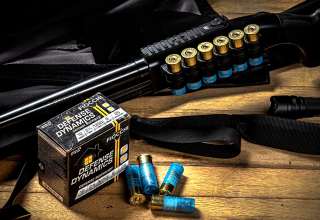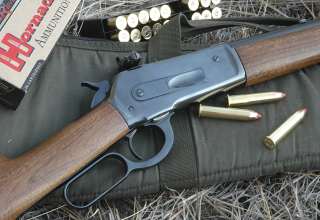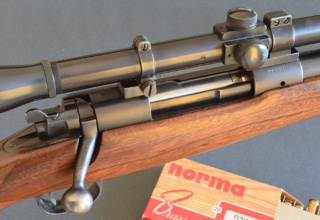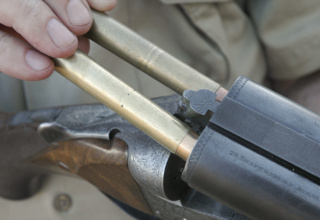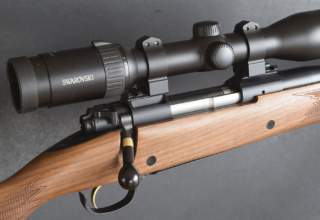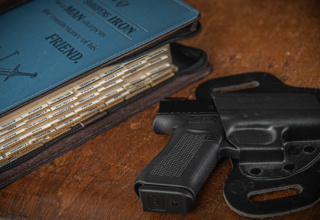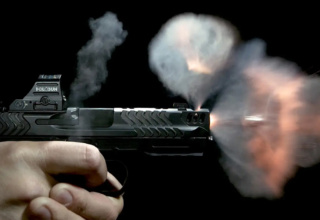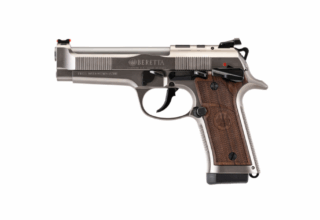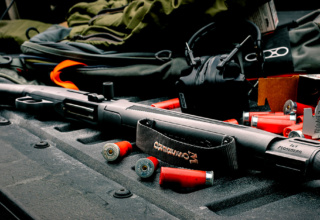As straight-walled rifle loads pass legal muster, do slugs still make sense? Which ones?
by Wayne van Zwoll
In those bright, innocent days before the Gun Control Act of 1968, I kept vigils for a Remington box under the postman’s arm. When it came, I nearly tore it from him. A 16-bore Wingmaster ($94 brand new), it had a modified choke and would serve for everything from woodcock to whitetails. Denied rifles by law, deer hunters in our Michigan county used Foster slugs in bird barrels.
Foster slugs are round-nosed missiles whose soft lead and angled ribs ease their passage through chokes. The ribs don’t impart much spin; these hollow-base slugs fly straight because they’re nose-heavy, like shuttlecocks. A wad blocks the base, so powder gas can’t open it to seal the bore, per Minie’s bullet.
American Karl Foster came up with his slug in the 1930s, three decades after Germany’s brilliant Wilhelm Brenneke designed a finned slug with a felt wad between two card wads screwed to its base.
In my youth, 12-bore Foster slugs weighed 1 ounce, or 438 grains. They left the muzzle at 1,600 fps—same as 350-grain Fosters from my 16 and 325s from 20-bores. Magnum 2 ¾-inch loads with 1 ¼-ounce slugs (547 grains) arrived later and gave up a bit of speed. In 3-inch shells, velocity went back up to 1,600. A 325-grain slug from a 3-inch 20-gauge shell now clocks about 1,680 fps; a .410 Foster 1,775. (A reminder: .410 is bore diameter in inches; other shotguns and their ammo are listed by gauge, the number of bore-diameter lead balls that weigh a pound). Perhaps because the hull is long and lean, the unwitting commonly assume a .410 slug at 1,800 fps is a laser-beam. In truth, the 109-grain .410 Foster is anemic and has a steep arc. Its 770 ft-lbs at the muzzle matches what a 16-gauge Foster carries to 100 yards.

The frothiest slug loads are formidable at iron-sight ranges. A 2 ¾-inch 12-bore magnum hits like a .30-30 to 125 yards – harder, really, as the slug’s weight and diameter get short-changed in the math. Of course, drag has its way with Fosters, which are aerodynamic duds. Velocity loss of up to 35 percent in the first 100 yards drains half the slug’s energy. A .410 slug expends over 60 percent of its thrust getting that far!
During the 1980s, the Foster slug gave way to the sabot (SAY-bow, French for a projectile inside a projectile). Sabot slugs come in bore-diameter capsules that impart spin from rifled bores and fall away in flight. Sabot bullets have higher sectional densities and ballistic coefficients than Foster slugs, so fly flatter and better retain energy. They’re lighter so they can be driven faster. As there’s no bore contact, sabot slugs can be of hard material for deep penetration.

The shift to sabots began when California-based Ballistics Research Institute (BRI) designed an hour-glass-shaped slug in a plastic sleeve split lengthwise. Prototype ammo in a rifled Benelli autoloader tore one-hole knots for me at 50 yards. Winchester bought BRI.
In 1993 a New Jersey shop announced its Lightfield Hybrid sabot, an almost-bore-diameter slug in a thin-walled, two-piece capsule. A nearby firm, Gun Servicing, was testing .45 ACP pistol bullets in a 12-gauge sabot. And Remington was about to announce its bullet-shaped 50-caliber Copper Solid sabot. By then, Barnes had its Expander MZ muzzle-loading bullet. Federal adopted this copper hollowpoint for Premium slug ammo around 1997. That year Hornady announced a sabot load.
The new millennium ushered a new Brenneke sabot load to PMC’s line. The Nevada firm stoked the 1-ounce slug to 1,600 fps. Winchester stole the spotlight with a 385-grain Partition Gold hollowpoint at 1,900 fps. This Nosler bullet delivered more than a ton and a half of energy at the muzzle, and reached 200 yards with 1,500 foot-pounds, trumping the .243 Winchester!

These days, many sabot slugs are jacketed rifle and pistol bullets in plastic cocoons. Remington’s Premier Accutip has a ventilated polymer tip atop a lead core jacketed by cartridge brass. My tests show this to be a very accurate slug. Claimed weight retention in gelatin at 100 yards: 98%! Premier Expander slug loads feature Barnes tipped copper hollowpoints. In 20 gauge, these 260- and 250-grain slugs get off the blocks at 1,825 to 1,900 fps. In 12 gauge, 385-grain AccuTips match that speed; 438-grain Expanders exit at 1,450 to 1,550. Besides Foster-style “Slugger” loads, Remington offers smoothbore shooters its slightly oversize flat-nose lead Buckhammer.
Winchester’s Foster loads include a 1 1/8-ounce 2 ¾-inch option that clocks 1,600 fps for nearly 2,800 ft-lbs. BRI sabots now have company in the Winchester line: Dual Bond, Partition Gold, and XP3 Tin Core slugs, 260 to 385 grains, at 1,725 to 2,000 fps. Federal lists 275- and 300-grain polymer-tipped Trophy Copper slugs in 20 and 12 gauge loads at 1,700 to 2,000 fps. Its 3/4- and 1-ounce Truball slugs for smoothbores have hard (high-antimony) missiles in poly spheres that center them in the bore.

Relatively new to the slugfest, Hornady has quickly bulked up its roster. Sabot loads feature FTX and MonoFlex tipped bullets from its centerfire rifle stable. A 325-grain Interlock hollowpoint also brings over 1,000 ft-lbs of 12-bore thump past 200 yards. Hornady loads Fosters atop a cushioning polymer wad.
SAAMI pressure limits for shotguns run about 12,000 psi, compared to over 50,000 for modern rifle rounds. Under that thrust ceiling, sabot slugs fly remarkably flat. Zeroed at 100 yards, the sleekest stay within 2 inches of sight-line to 125 and fall 4 inches at about 150, where even 20-bore slugs deal a half-ton blow. Rifled bores give them accuracy Fosters can’t match. Sabot ammo in rifled shotguns (1-in-28 to 1-in-35 twist) can shoot into 2 ½ MOA, as accurately as many rifles. The spin of sabot slugs adds some stability in thickets. Incidentally, while the weight of both sabot and Foster slugs from 12-bore guns hints at “brush-busting” travel, they still deflect. My trials showed 12-gauge Fosters drill thin brush only a bit more reliably than 150- to 250-grain rifle bullets popular for deer. Targets behind screens of branches also evidenced deformation and tipping.
Some states have amended shotgun-only restrictions for deer hunting in populated areas to permit use of specified straight-walled rifle cartridges with limited reach. Are they more effective than top sabot loads from shotguns? Winchester’s new .350 Legend is a pitch to hunters now given the choice. Its 180-grain Power-Point bullet leaves the muzzle at 2,100 fps with 1,760 ft-lbs of energy. At 100 yards, it packs 1,240 ft-lbs, same as a 260-grain Partition Gold bullet from a 2 ¾-inch 20-bore load. A 3-inch 12-gauge load with that slug delivers a ton of smash at 100 yards and shoots about as flat as the .350 to 200.

The increasing use of scopes in cantilevered mounts on pump and autoloading shotguns has hiked their effective reach. While bullets from modern bottleneck rifle rounds have the edge beyond 200 yards, sabot slugs are certainly their equal in the woods, where most whitetail deer are shot.
Really? A shotgun?

In 1966 Bill Ruger tweaked an 1872 action by John Farquharson of Daldhu, Scotland, to build the No. 1 rifle. Decades later at New England Custom Gun (Claremont NH), Mark Cromwell and metalsmith Mark Petersen re-worked the linkage and installed a 20-gauge barrel turned from a Verney-Carron blank. “No small task,” deadpanned both Marks. Pete Johnson fitted walnut from a No. 1 in .450/400. A banded front sight and a NECG Half Moon rear sight complement a 1.1-4x Schmidt & Bender in Talley rings. In my trials, 260-grain Remington AccuTips and 250-grain Hornady SSTs from this elegant shotgun stayed inside 3 inches at 100 yards. Winchester Partition Golds edged both by half an inch.
Cut-shell: the first slug.
The cost of Foster slugs drove Depression-era deer hunters to desperate measures – like scoring the hulls of shotshells around the wad. When fired, the shell’s entire front half left the chamber, to pass with protest through forcing cone, bore, and choke. Shotguns and insurance companies disliked cut-shells. Accuracy was poor. But at short range the hull-encapsulated shot charge hit like a slug. Firing cut-shells today would no doubt void shotgun warranties.


